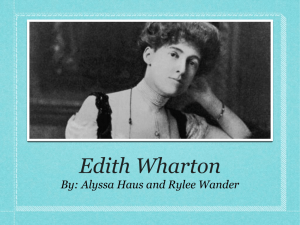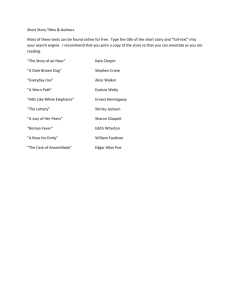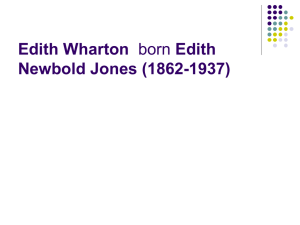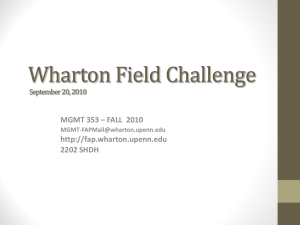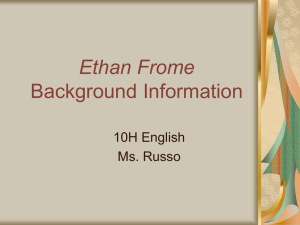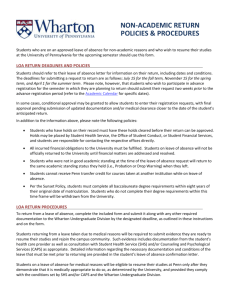Document 10464512
advertisement
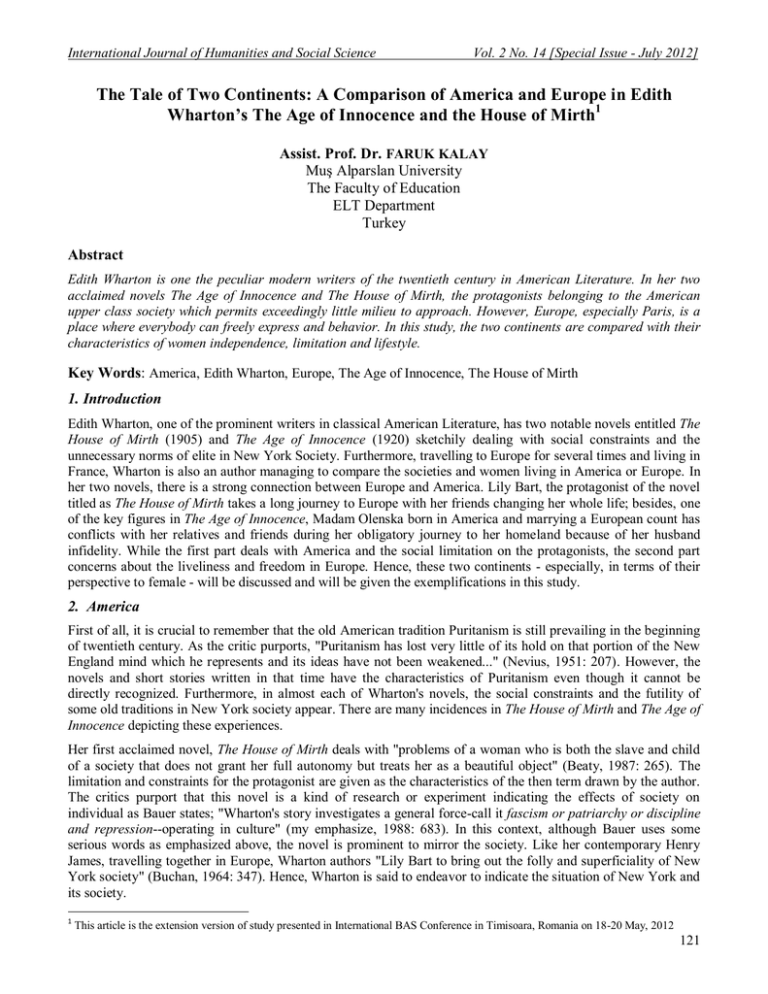
International Journal of Humanities and Social Science Vol. 2 No. 14 [Special Issue - July 2012] The Tale of Two Continents: A Comparison of America and Europe in Edith Wharton’s The Age of Innocence and the House of Mirth1 Assist. Prof. Dr. FARUK KALAY Muş Alparslan University The Faculty of Education ELT Department Turkey Abstract Edith Wharton is one the peculiar modern writers of the twentieth century in American Literature. In her two acclaimed novels The Age of Innocence and The House of Mirth, the protagonists belonging to the American upper class society which permits exceedingly little milieu to approach. However, Europe, especially Paris, is a place where everybody can freely express and behavior. In this study, the two continents are compared with their characteristics of women independence, limitation and lifestyle. Key Words: America, Edith Wharton, Europe, The Age of Innocence, The House of Mirth 1. Introduction Edith Wharton, one of the prominent writers in classical American Literature, has two notable novels entitled The House of Mirth (1905) and The Age of Innocence (1920) sketchily dealing with social constraints and the unnecessary norms of elite in New York Society. Furthermore, travelling to Europe for several times and living in France, Wharton is also an author managing to compare the societies and women living in America or Europe. In her two novels, there is a strong connection between Europe and America. Lily Bart, the protagonist of the novel titled as The House of Mirth takes a long journey to Europe with her friends changing her whole life; besides, one of the key figures in The Age of Innocence, Madam Olenska born in America and marrying a European count has conflicts with her relatives and friends during her obligatory journey to her homeland because of her husband infidelity. While the first part deals with America and the social limitation on the protagonists, the second part concerns about the liveliness and freedom in Europe. Hence, these two continents - especially, in terms of their perspective to female - will be discussed and will be given the exemplifications in this study. 2. America First of all, it is crucial to remember that the old American tradition Puritanism is still prevailing in the beginning of twentieth century. As the critic purports, "Puritanism has lost very little of its hold on that portion of the New England mind which he represents and its ideas have not been weakened..." (Nevius, 1951: 207). However, the novels and short stories written in that time have the characteristics of Puritanism even though it cannot be directly recognized. Furthermore, in almost each of Wharton's novels, the social constraints and the futility of some old traditions in New York society appear. There are many incidences in The House of Mirth and The Age of Innocence depicting these experiences. Her first acclaimed novel, The House of Mirth deals with "problems of a woman who is both the slave and child of a society that does not grant her full autonomy but treats her as a beautiful object" (Beaty, 1987: 265). The limitation and constraints for the protagonist are given as the characteristics of the then term drawn by the author. The critics purport that this novel is a kind of research or experiment indicating the effects of society on individual as Bauer states; "Wharton's story investigates a general force-call it fascism or patriarchy or discipline and repression--operating in culture" (my emphasize, 1988: 683). In this context, although Bauer uses some serious words as emphasized above, the novel is prominent to mirror the society. Like her contemporary Henry James, travelling together in Europe, Wharton authors "Lily Bart to bring out the folly and superficiality of New York society" (Buchan, 1964: 347). Hence, Wharton is said to endeavor to indicate the situation of New York and its society. 1 This article is the extension version of study presented in International BAS Conference in Timisoara, Romania on 18-20 May, 2012 121 The Special Issue on Social Science Research © Centre for Promoting Ideas, USA www.ijhssnet.com To make an exemplification, Lily Bart has to live like 'tableaux vivants' which is resulted in her suicide. The realization of others' desire and preferences make her the slave and anti-prototype of her contemporaries. Despite being in the circle of upper-class society, Lily Bart is not able to be free enough to live how she desires. Wharton emphasizes the incidences in the novel as; She had been long enough in bondage to other people's pleasure to be considerate of those who depended on hers, and in her bitter moods it sometimes struck her that she and her maid were in the same position, except that the latter received her wages more regularly. (Wharton, 1997: 24-5) On the other hand, not realizing how she is, Lily cannot give up her status and identity. In the foreword, the critic indicates denying the recantation from her habit which leads to her own catastrophe and isolation; "To become a working girl, in the straightforward sense of the term, is finally the only alternative left to Lily but, outstanding as she is at wearing hats, she cannot manage to assemble them" (Beer, 1997: xiv-xv). In this sense, there will be a psychological problem, the protagonist symbolizing the individuals living in New York Society encounters. Not only does Lily represent the peculiarity in the society but also the other members can be regarded as unrivalled examples in the novel. Needless to say, Mrs. Peniston, the protagonist's wealthy aunt depicted by Wharton is a distinctive character who is insensible of what is going on and tries to maintain the upper-class custom regardless of thinking about her niece's deprivation. For example, "Mrs. Peniston disliked giving dinners, but she had a high sense of family obligation..." (Wharton, 1997: 108). When thought about such a place where it is inevitable for Lily Bart to live, it is not surprising for the readers that Lily gets the desire of gambling and the feeling of consternation. Luria depicts the house as; "a Poe-like setting where one is buried alive" (1997: 308). What's more, the society's point of view to Lily Bart is humiliation and mortification. The society does not accept the discrepancy in itself, which puts America into hard conditions. In this sense, identifying or, in fact, labeling the person as 'bad' is a general characteristic of the term liken the example in the novel given below; There had of course been "fast" girls even in Mrs. Peniston's early experience; but their fastness, at worst, was understood to be a mere excess of animal spirits, against which there could be no graver charge than that of being "unladylike." (Wharton, 1997: 112) Furthermore, New York is depicted as the place of both dullness and the lack of excitement by Wharton. "Other cities put on their best clothes in summer, but New York seems to sit in its shirtsleeves" (Wharton, 1997: 5). This scruffiness reverberates the society's constraints and limitation. Moreover, the individuals - especially upper class people - are lost in conjecture and depression of New York. "In anthropological terms the inhabitants of old New York are all representatives of an endangered species but it is moral inertia rather than physical..." (Beer, 1997: xv). The upperclassman is deformed by applying as great number of exaggerative traditions, which symbolize the American society. Representing one of the figures, Lily Bart clearly states this situation by saying as; There was no one, I mean, to tell me about the republic of the spirit." "There never is--it's a country one has to find the way to one's self." "But I should never have found my way there if you hadn't told me." "Ah, there are sign-posts--but one has to know how to read them." (Wharton, 1997: 60) Needless to say, Lily Bart both disappears and perishes in New York society in the consequent of Lily's fears such as the lack of money and candidate of ideal husband. Wharton criticizes the upperclassmen's manners and attitudes. Sensibar, emphasizing the protagonist's mentality and the society's expectations from her thoughts that Wharton manages to give the exact message. She states as; In Wharton's first highly acclaimed novel, The House of Mirth (1905), she had used the image of Lilly Bart as "human merchandise," literally confined in a tableau vivant, to criticize the economic and sexual exchange systems and debased moral values of rich Manhattan Victorians. (Sensibar, 1990: 188) What's more, The Age of Innocence has the same characteristics with the novel aforementioned. Two important women figures, May Welland, representing America, Ellen Olenska, symbolizing the Europe are attended in the novel by Wharton trying to reflect the feminine situation in both continents. 122 International Journal of Humanities and Social Science Vol. 2 No. 14 [Special Issue - July 2012] However, while Ellen is more lifelike, calmer in the presence of obstacles encountered, May is raised for being the perfect wife, which is the ordinal characteristic of the then term. Ellen is delineated as the victim of the upperclass society; in addition, New York is again the center of bizarre traditions and customs. The critic summarizes the novel as; "...the story of the re-introduction of the scandalous Countess Olenska to late nineteenth- century New York society..." (Nicholls, 2004: 26). In this sense, compared with The House of Mirth aforementioned, there is no change in Wharton's mind about New York. In the novel, the bad characteristics of the city are juxtaposed by the author. Newland Archer interprets the people's emotion by uttering as “all this modern newspaper rubbish about a New York aristocracy" (Wharton, 2008: 35). The traditions and social norms emphasized in the novel are the suspicions of failure of New York society. For example, the disapprobation of Ellen's name is a sign of arrogance and excessive constraints in New York society. “...such an ugly name as Ellen. I should have changed it to Elaine” (Wharton, 2008: 28). It indicates the social pressure in the new continent. What is more, dealing with the same issue, a great number of critics give the exemplification of New York aristocracy. The critic purports as; In The Age of Innocence New Yorkers' attendance at a performance of Gounod's Faustis used by Wharton only to belittle them, a purpose unrestrained by the fact that Wharton will also allow Ellen Olenska to make only a token challenge to their world.. (Hutchinson, 2000: 952) Furthermore, some of the odd traditions are also satirized by the author herself. Wedding ceremonies, the relationship between male and female and other traditions are always connected with some formal situations, which are indicated in these novels. Especially, in The Age of Innocence, "Edith Wharton brilliantly satirized the anxiety this lack of fixity could cause in her portrayal of the wedding of May Welland and Newland Archer in 1870s New York" (Penner, 2004: 18). As Penner purports, Wharton mirrors the upperclassmen's peculiarity and the constraints of New York society. Also, the other distinctive thing in the novel is the comparison of Ellen and May. Ellen is more independent and she possesses self-confidence more than May does. In fact, it is related to the way she is brought up in the society because she endeavors to be a perfect wife as the other girls living in aristocratic families. As Moseley states "Ellen, momentarily separated from her husband, a Polish count, is everything that May is not" (1959: 157). Even though the sentence the critic uses may as well be serious and repressive, it has the reasonable side. On the other hand, the mission consigned to Ellen is also a distinctive factor emphasized by the critics. Representing the New York aristocracy, Newland Archer is stimulated by Ellen Olenska. Newland Archer's antithesis and resistance emerge from Ellen's situation, which make him protectionist. Nowlin summarizes this incidence as; Uprooted from old New York since childhood, Ellen is the chief catalyst of Newland's awakening. We can only surmise that she finally found herself "at home" in France, for, repeatedly associated with Napoleonic France, she carries French ways with her throughout the novel, having gotten rid of bogies, cleared her mind of shams, and "gone up to the Medusa and the Sphinx with a cool and a penetrating question," without ever losing her deeply realistic sense of the binding power of culture. (2004: 106) In both novels, America -especially New York - is depicted as the center of dullness and a society which has bizarre customs. Although the critics have the reasonable subjects to criticize Wharton because her "knowledge of the Middle West and of New York in the 20's was gained from hearsay and reading rather than directly" (Buchan, 1964: 343), she manages to describe how the upper-class society is. The requirement of expenditure desired by the society costs Lily Bart's life. As the critic comments on the protagonist, "Scruples have no place in the world depicted in The House of Mirth; thus, in good naturalistic fashion, the environment becomes the force which crushes the protagonist" (Rubin, 1957: 183). Ellen cannot freely live her life while May is stuck in the middle of the expectancy of society. 3. Europe The Europe always becomes a source of inspiration for Wharton. There are great numbers of European writers and scholars who influence the writer a lot. "Edith Wharton's exposure to and appreciation of German realism" (Evans, 1992: 361) can be regarded as a fine example to illustrate. 123 The Special Issue on Social Science Research © Centre for Promoting Ideas, USA www.ijhssnet.com Also, Verduin alleges that "Wharton owed much to concurrent promotion of Dante" (Verduin, 2004: 96). In this context, Europe can be said to have very important impact for her literary world. Rather than living in America, she spends much of her life in Europe, especially in Paris. The sixty nine trip to this continent glorify her love. In her novel The House of Mirth, Wharton sees Europe as a better place and a fantasy world. Both people and places in the continent are charming and Lily Bart forgets the bad experiences in New York. "But the weeks at Cannes and Nice had really given her more pleasure" (Wharton, 1997: 171). Also, "It isn't so bad on Italian nights--then she comes late, and there's time to digest" (Wharton, 1997: 105). This conversation makes the reader think about the fantastic incidence. On the other hand, as aforementioned, the people met are friendly and charming rather than those who live in New York aristocracy. "... Duchess. Charming woman, the Duchess, you understand; and a very good friend of mine..." (Wharton, 1997: 169). When compared these two continents, it can be easily observed that America is stricter and more conservative specifically for women. The critic states; "The woman's world of social and domestic interaction has never been seen, especially in discussions of literature, as typical of America. (Joslin, 1987: 203). It is indispensable that Europe becomes livable place. Furthermore, some of the critics make a further step and suggest the "Europeanizing" New York society" (Nathan, 1987: 278). Hence, it is clear that Wharton attempts to throw the Puritan clothes away in her novels. On the other hand, it can be definitely noticed "...the atrophy experienced by these New Yorkers, which is moral as well as physical..." (Beer and Horner, 2007: 179). Furthermore, in every opportunity, Wharton specifies Lily's happiness and felicity in the novel when she is in Europe. For these reasons, it can be stated that Lily bored with both the society's and her aunt's pressure is happier and more joyful in her long trip to Europe. As regards The Age of Innocence, the situation is a bit more complicated from the point of the circumstance of two prominent women figures, which will be dealt later. Again, the places have the characteristics of joyfulness and glorification. The depiction of milieu made by Wharton whets the readers' curiosity. To make an exemplification, even May is impressed so much as authored in the novel; In London nothing interested her but the theatres and the shops; and she found the theatres less exciting than the Paris cafés chantants where, under the blossoming horse-chestnuts of the Champs Àlysées, she had had the novel experience of looking down from the restaurant terrace on an audience of cocottes, and having her husband interpret to her as much of the songs as he thought suitable for bridal ears. (Wharton, 2008: 136) Moreover, New York still becomes a city which is lack of art, normal relationships and feminine freedom. Beaufort's question clarifies my argument: “Painters? Are there painters in New York?” (Wharton, 2008: 75). Considering that Europe has many an art center including theatres and operas, it is surprising that there are no painters in New York. On the other hand, the characters who adopt themselves in terms of the conditions of Europe revolt against the contradictions and traditions in New York aristocracy. Newland Archer is one of the best characters given as an example in the novel. For instance, Newland "did not mind being flippant about New York" (Wharton, 2008: 52). What's more, the conversation between Newland and Ellen indicates their propensity to have freedom. "She wanted to keep me with her; but I had to be free—” ... He saw his chance. “Everything may be labelled— but everybody is not” (Wharton, 2008: 54). In this context, Europe has a deep impact on the figures' characters and points of view. The reason why Newland cannot decide on whether he must marry Ellen or May is that he does not consider May so independent as Ellen. Brought up for being the best bride for her husband, May differs from Ellen in many ways. May implying the fictional world, states “We can’t behave like people in novels, though, can we?” (Wharton, 2008: 59). On the other hand, While travelling in Europe, May confronts with a great number of things which are both surprising and fazing for her. The arguments with her husband Newland in Paris indicate that America would not be the same as Europe. In the novel, Wharton has May speak as; 124 International Journal of Humanities and Social Science Vol. 2 No. 14 [Special Issue - July 2012] “Well—that kind of thing happens in other places, and the world still goes on.” “I don’t suppose, dear, you’re really defending the French Sunday?” “I’ve heard you often enough, mother, grumble at the English Sunday when we’ve been in London.” “New York is neither Paris nor London.” “Oh, no, it’s not!” her son groaned. (Wharton, 2008: 62) Ellen, representing Europe, is analyzed by many critics. On the one hand, some claim that she is a contemporary figure, ideal for modern America and the others allege the sacrifice of European society. Bellringer thinks that she has hesitation for what her nationality. "The result of this curse was that she could not feel securely American" (Bellringer, 1985: 110). So, it is evident that Europe becomes a dreamland and a place the characters can freely express what they think. IV. Conclusion The main characters of the novels The House of Mirth and The Age of Innocence, Lily Bart and Ellen Olenska are the victims of New York upper-class society. The pressures made by their American society force them to live a life they do not deserve. While Lily cannot stand and kills herself, Ellen Olenska has to live with her husband she dislikes. The critics assess that the upperclassman endeavors to keep their social norms and traditions. Although I have read Wharton's portrayal of the guardians of elite society as representations of cultural tendencies, it is important to remember that real people assumed the responsibility for preserving proper social form in late 19th Century New York. (Thurtle, 2002: 52) On the other hand, Europe -especially Paris, London and Vienna - diverges from America forcing their citizens to behave like someone else. The characters escaping from the social pressure and wanting to spend good time go to Europe. In this sense, Wharton writing these prominent novels makes a difference among her contemporaries. References Bauer, D. M. (1988) Edith Wharton's "Roman Fever": A Rune of History" College English 50/6 681-693 Beer, J. & Horner, A. (2007). "Wharton the 'Renovator': 'Twilight Sleep' as Gothic Satire" The Yearbook of English Studies, 37/1 177-192 Beaty, R. (1987). "Lilies That Fester: Sentimentality in "The House of Mirth" College Literature, 14/3 263-275 Bellringer, A. W. (1985). "Edith Wharton's Use of France" The Yearbook of English Studies, 15 109-124 Buchan, A. M. (1964). Edith Wharton and "The Elusive Bright-Winged Thing" The New England Quarterly, 37/3:343-362 Evans, T. S. (1992) Edith Wharton and Poetic Realism: An Impasse" The German Quarterly 65 (3/4) 361-368 Hutchinson, S. (2000). "Beyond" George Eliot? Reconsidering Edith Wharton" The Modern Language Review, 95/4 942-953 Joslin, K. (1987). "Edith Wharton at 125" College Literature 14/3 193-206 Luria, S. (1997). "The Architecture of Manners: Henry James, Edith Wharton, and the Mount" American Quarterly, 49/2 298-327 Moseley, E. M. (1959). "The Age of Innocence: Edith Wharton's Weak Faust" College English, 21/3 156-160 Nathan, R. (1987). Ward McAllister: Beau Nash of "The Age of Innocence" College Literature, 14/3, 277-284 Nevius, B. (1951). "Ethan Frome" and the Themes of Edith Wharton's Fiction” The New England Quarterly, 24/2 197-207 Nicholls, M. (2004). Male Melancholia and Martin Scorsese's The Age of Innocence Film Quarterly, 58/1 25-35 Nowlin, M. (2004). "Edith Wharton's Higher Provincialism: "French Ways" for Americans and the Ends of "The Age of Innocence" Journal of American Studies, 38/1 89-108 Penner, B. (2004) “A Vision of Love and Luxury” The Commercialization of Nineteenth Century American Weddings 39/1 :1-20 Rubin, L. (1957). "Aspects of Naturalism in Four Novels by Edith Wharton" Twentieth Century Literature 2/4 182-192 Sensibar, J. L. (1990). "Behind the Lines" in Edith Wharton's "A Son at the Front": Rewriting a Masculinist Tradition" Journal of American Studies, 24/2 187-198 Thurtle, P. (2002). "Harnessing Heredity in Gilded Age America: Middle Class Mores and Industrial Breeding in a Cultural Context" Journal of the History of Biology 35/1 43-78 Verduin, K. (2004) "Edith Wharton, Adultery, and the Reception of Francesca da Rimini" Dante Studies, with the Annual Report of the Dante Society, 122 95-136 Wharton, E. (1997) The House of Mirth London: Wordsworth Classics .........................(2008) The Age of Innocence, New York: Oxford University Press 125
